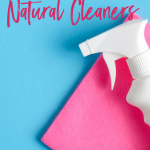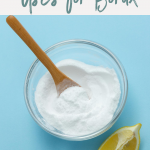This post may contain affiliate links. Click here to read my affiliate disclaimer policy.

If you are new to canning, check out these 10 canning tips for the newbie canner! Canning is a great way to eat healthy, save money and meal prep for your entire family.
Here are 10 canning tips for the newbie canner:
1. If you don’t have a “Ball Blue Book“, get one. It’s priceless and so is the information in it.
2. Always check the lips of your jars carefully with your finger EVERY time you want to can, but BEFORE you do ANYTHING with them. It’ll save you time and trouble down the road.
Also inspect them for chips, cracks, or other defects. Some minor irregularity will be present in the lip. What’s most important is detecting chips or cracks before use.
The reason for this is it will allow you to have batches that seal every single time without any jars failing to seal. If one should fail, it will be only one out of a hundred or more jars.
3. If the jar is already packed and full and it cracks, ruptures, shatters, or otherwise becomes compromised throw jar and all contents away. You don’t want to risk glass contamination in your food.
If you load the jar and then discover a defect in the lip, but the jar integrity is still good, empty the jar and transfer the contents to another jar then throw the bad jar away.
4. If a jar fails to seal, change lids and try again. If it fails twice, stick it in the fridge and eat it for dinner. Also, mark the jar as possibly bad and give it an extra careful inspection. If you find a defect, empty out the contents and dispose of the jar.
5. Supply rule of thumb for canning. Note the maximum number of jars you will need for one year worth of meals. Not 365 days * 3 meals a day, but rather the number of jars of home canned food you use in a month * 12 months, then multiply that by 1.5x’s. So basically 1 month worth of usage * 18 months = total jars you will need.
This allows you to store larger amounts of home canned food, and also be able to adapt more readily to lean and fat years. With fat years you’ll have the extra jars to absorb the overage, and in lean years you’ll have the extra stock to carry you over until better times. It also makes a nice rainy day cushion in case you’re forced to eat off your shelves more than normal, such as during a power outage, shortage, bitter cold winter day, relatives, special occasions, etc.
If you think you need more than 1.5x’s your yearly usage, feel free to have that many jars on hand if that’s what your needs call for, or you feel comfortable having.
6. Always have 3-4 lids per jar you own on hand at all times. IE, 20 jars = 60-80 lids. The reason behind this stems from a problem my parents encountered several times back in the 80’s and 90’s.
Due to a production problem by the canning companies, as well as a sudden and unexpected surge of demand, a shortage of canning lids ensued for somewhere around 9 months or so where lids were almost impossible to find, and insanely expensive because of it.
Should something like that happen again, or your usage should spike for any particular reason, you’ll always have a good supply of lids on hand to tide you over until you can restock.
7. Rings. Always have enough canning rings for between 1/3rd to 1/2 of all your jars. This is because they will wear out faster than you think, and if you’re doing a lot of batches during harvest time, you will go through rings like crazy.
Also, if you give away jars to your friends, you will need to send the jars with their own rings to ensure safe transportation of the canned food.
8. Always have a good selection of jars, both wide and regular mouth, and in half pint, pint, and quart sizes. IE, going back to point #5, if you have 100 jars, make sure that they’re not all one type of jar, because you will find need from time to time to use wide mouth quart for one item, regular mouth point for another, half pint for jams and jellies, etc. IE, vary your stock based on your needs.
If you’re not certain, experiment and find out where your needs are greatest and adjust your ratios accordingly.
9. Regular mouth jars are best for fruits and vegetables. Wide mouth jars are best for meats and very dense items, such as squash or other items with a high internal density. The idea behind this is you use the wide mouth jars when the item is hard to remove, and regular mouth when it’s not.
10. You can not only pressure can, and water bath your foods, but you can also dry can items such as flour, cake mixes, pasta, beans, etc. To dry can there are two methods. The first is the oven method. 20 minutes at 350F will be enough to seal them. Or use a vacuum sealer with the jar sealer attachment.
One note of caution. When dry canning, since the lid doesn’t get the heat it needs to conform itself around the lip, you will need to put a ring on immediately after sealing (you don’t use a ring when initially sealing the jar, only after it’s sealed) to ensure that the lid remains in place.
Purchase Mason Jars For Canning Here!
Also check out: The Top 5 Benefits of Canning
Amazon and the Amazon logo are trademarks of Amazon.com, Inc, or its affiliates.





